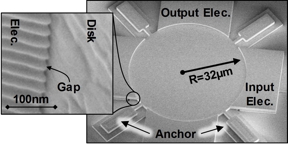Home > Press > First Capacitive Transducer with 13nm Gap
 |
Abstract:
Fabrication of sub-30nm gap for capacitive transducers seemed impossible, until recently. Researchers at UC Berkeley successfully demonstrated a 13nm-gap capacitive resonator, which will improve sensor and resonator performance by orders of magnitude.
First Capacitive Transducer with 13nm Gap
Berkeley, CA | Posted on July 27th, 2017Capacitive-gap transduced resonators are well known to provide high on-chip quality factors (Q), with values reaching 150,000 at VHF and 40,000 at 3GHz. Q’s this high enable 0.1% bandwidth channel-select filters with low insertion loss and high rejection for ultra-low power transceivers. At HF (from 3-30MHz), capacitive-gap transduced resonators also post strong electromechanical coupling, as gauged by (Cx/Co), up to 30%, which outperforms all other technologies. However, application of these transducers as the main filters of the smartphone (with market value more than $10b) requires strong electromechanical coupling at gigahertz frequencies. To achieve such a high coupling, transducers need to have gap spacing as small as 20 nanometers or less.
Researchers at University of California Berkeley demonstrated electrode-to-resonator gaps as small as 13.2nm achieved on a 59.5-MHz capacitive-gap transduced disk resonator which enabled a measured electromechanical coupling strength Cx/Co greater than 1.62% at a bias voltage of only 5.5V, which exceeds that of any competing technology, macro or micro, capacitive or piezoelectric, at similar VHF frequencies, all while retaining an unloaded quality factor Q of 29,640. Several key discoveries contribute to this successful demonstration, which include a novel polysilicon etch recipe that enables considerably smoother etch sidewalls than previously achievable, allowing more uniform sidewall sacrificial layer deposition and preventing structure pull-in by removing disparities and their associated strong electric fields. The implementation of small gap has improved the electromechanical coupling by more than 10x compared to previous resonators and its figure-of-merit measured as kt
2Q=576.2 holds the world’s record. This combination of high Cx/Co and Q, which has long been a primary driver for RF MEMS research, stands to not only cut VHF low noise oscillator power consumption to sub-µW levels, but now creates opportunities to apply MEMS resonator technology to the highly profitable and lucrative RF filter market for smartphones.
####
For more information, please click here
Contacts:
Jalal Naghsh Nilchi
Phone: 510-918-4346
Fax:
E-mail:
Copyright © University of California Berkeley
If you have a comment, please Contact us.Issuers of news releases, not 7th Wave, Inc. or Nanotechnology Now, are solely responsible for the accuracy of the content.
| Related News Press |
News and information
![]() Researchers develop molecular qubits that communicate at telecom frequencies October 3rd, 2025
Researchers develop molecular qubits that communicate at telecom frequencies October 3rd, 2025
![]() Next-generation quantum communication October 3rd, 2025
Next-generation quantum communication October 3rd, 2025
![]() "Nanoreactor" cage uses visible light for catalytic and ultra-selective cross-cycloadditions October 3rd, 2025
"Nanoreactor" cage uses visible light for catalytic and ultra-selective cross-cycloadditions October 3rd, 2025
Hardware
![]() The present and future of computing get a boost from new research July 21st, 2023
The present and future of computing get a boost from new research July 21st, 2023
![]() A Carbon Nanotube Microprocessor Mature Enough to Say Hello: Three new breakthroughs make commercial nanotube processors possible March 2nd, 2020
A Carbon Nanotube Microprocessor Mature Enough to Say Hello: Three new breakthroughs make commercial nanotube processors possible March 2nd, 2020
![]() Powering the future: Smallest all-digital circuit opens doors to 5 nm next-gen semiconductor February 11th, 2020
Powering the future: Smallest all-digital circuit opens doors to 5 nm next-gen semiconductor February 11th, 2020
MEMS
Chip Technology
![]() Lab to industry: InSe wafer-scale breakthrough for future electronics August 8th, 2025
Lab to industry: InSe wafer-scale breakthrough for future electronics August 8th, 2025
![]() A 1960s idea inspires NBI researchers to study hitherto inaccessible quantum states June 6th, 2025
A 1960s idea inspires NBI researchers to study hitherto inaccessible quantum states June 6th, 2025
![]() Programmable electron-induced color router array May 14th, 2025
Programmable electron-induced color router array May 14th, 2025
Discoveries
![]() Researchers develop molecular qubits that communicate at telecom frequencies October 3rd, 2025
Researchers develop molecular qubits that communicate at telecom frequencies October 3rd, 2025
![]() Next-generation quantum communication October 3rd, 2025
Next-generation quantum communication October 3rd, 2025
![]() "Nanoreactor" cage uses visible light for catalytic and ultra-selective cross-cycloadditions October 3rd, 2025
"Nanoreactor" cage uses visible light for catalytic and ultra-selective cross-cycloadditions October 3rd, 2025
Announcements
![]() Rice membrane extracts lithium from brines with greater speed, less waste October 3rd, 2025
Rice membrane extracts lithium from brines with greater speed, less waste October 3rd, 2025
![]() Researchers develop molecular qubits that communicate at telecom frequencies October 3rd, 2025
Researchers develop molecular qubits that communicate at telecom frequencies October 3rd, 2025
![]() Next-generation quantum communication October 3rd, 2025
Next-generation quantum communication October 3rd, 2025
![]() "Nanoreactor" cage uses visible light for catalytic and ultra-selective cross-cycloadditions October 3rd, 2025
"Nanoreactor" cage uses visible light for catalytic and ultra-selective cross-cycloadditions October 3rd, 2025
Interviews/Book Reviews/Essays/Reports/Podcasts/Journals/White papers/Posters
![]() Spinel-type sulfide semiconductors to operate the next-generation LEDs and solar cells For solar-cell absorbers and green-LED source October 3rd, 2025
Spinel-type sulfide semiconductors to operate the next-generation LEDs and solar cells For solar-cell absorbers and green-LED source October 3rd, 2025
![]() Rice membrane extracts lithium from brines with greater speed, less waste October 3rd, 2025
Rice membrane extracts lithium from brines with greater speed, less waste October 3rd, 2025
|
|
||
|
|
||
| The latest news from around the world, FREE | ||
|
|
||
|
|
||
| Premium Products | ||
|
|
||
|
Only the news you want to read!
Learn More |
||
|
|
||
|
Full-service, expert consulting
Learn More |
||
|
|
||








